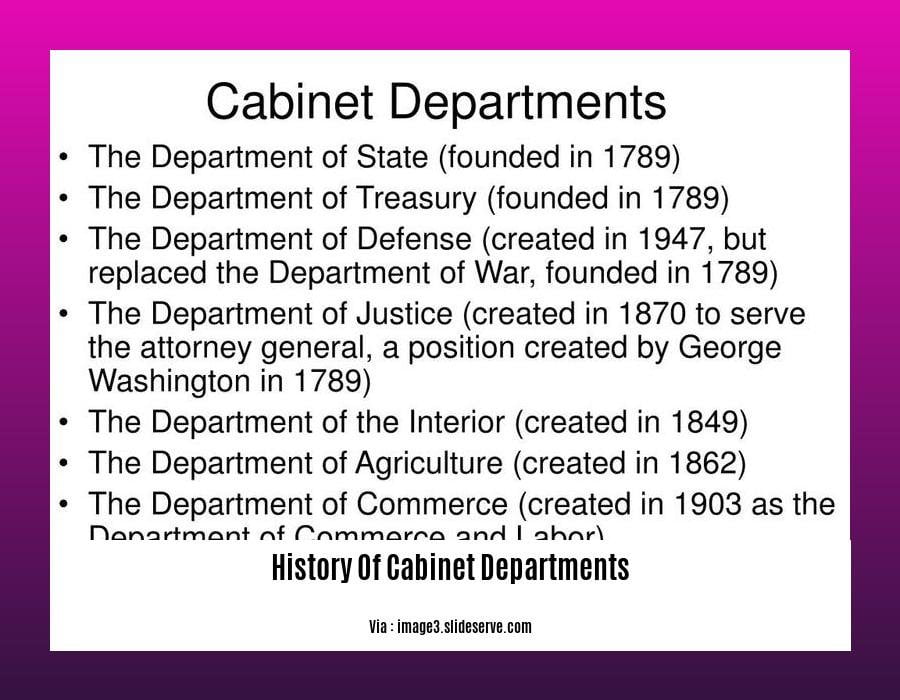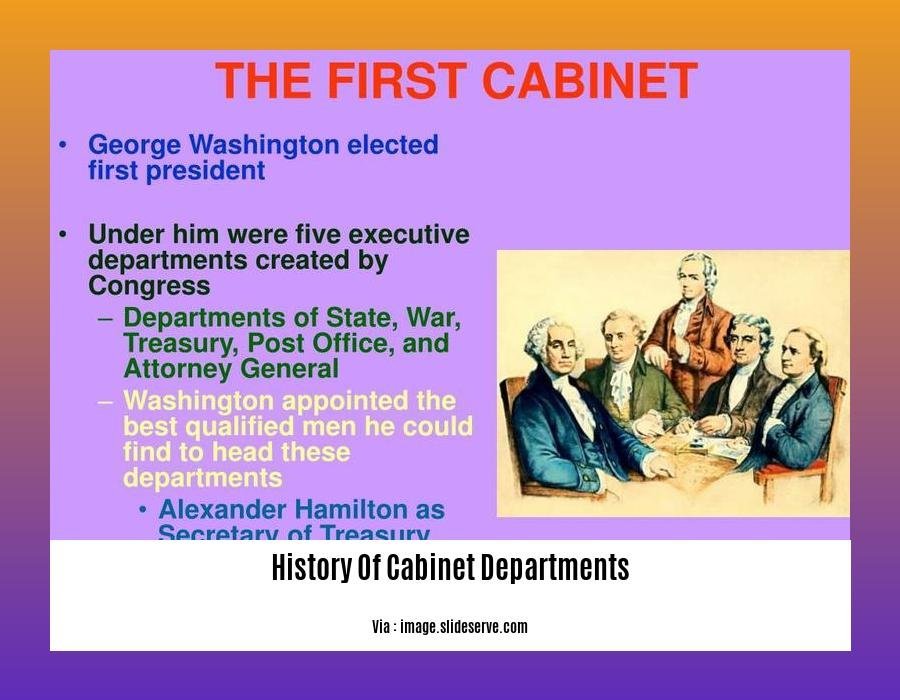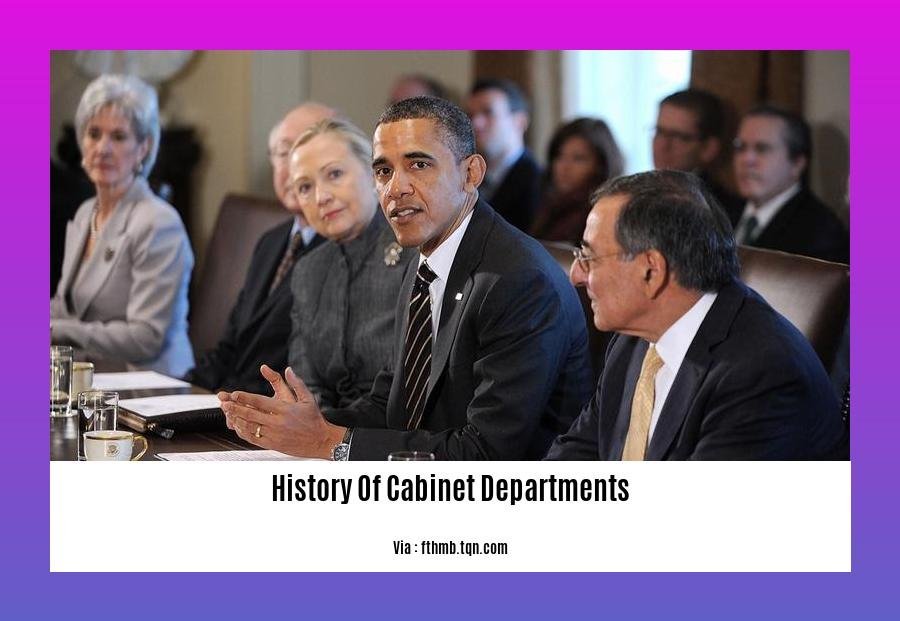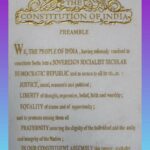Prepare yourself for a journey through the corridors of governance as we explore the rich history of cabinet departments. From their inception to their present-day roles, we will unveil the stories of these vital institutions that have shaped the course of American history and continue to play a pivotal role in our nation’s governance.
Key Takeaways:
- The cabinet system originated in Great Britain from the Privy Council.
- Cabinets advise the head of state and lead government departments.
- Cabinet structure varies among countries, but are common in parliamentary governments.
History of Cabinet Departments

Hey there, history buffs and governance enthusiasts! Let’s dive into the fascinating History of Cabinet Departments.
Cabinet departments, like trusty advisors, have been around for centuries. They first emerged in Great Britain as a group of advisors to the monarch. Over time, cabinet members became heads of key government departments, making them pivotal players in shaping the nation’s destiny.
In the United States, the cabinet system took root after the American Revolution. George Washington, our first president, formed a cabinet to guide him on matters of state. Initially, the cabinet consisted of the Secretaries of State, Treasury, and War.
As the nation grew, so did the number of cabinet departments. Each new department reflected the evolving needs of a burgeoning country. The Department of the Interior, for instance, was established to manage the vast western territories. The Department of Commerce, on the other hand, was created to promote economic growth.
Throughout history, cabinet departments have played a central role in shaping American governance. They’ve advised presidents, drafted legislation, and implemented policies that have impacted the lives of countless citizens. From foreign affairs to domestic affairs, cabinet departments have been at the heart of the nation’s decision-making process.
So, next time you hear about a cabinet meeting, remember that you’re witnessing a legacy that spans centuries. The history of cabinet departments is a testament to the enduring power of governance and the vital role it plays in our lives.
- To know more about the evolution and invention of carpentry, read our highly exceptional blog regarding the History of Cabinet Making.
- Explore cabinetry relics at their nascent stage in our comprehensive piece exclusively dedicated to the History of Cabinets
- Dive into the fascinating history of Cabinet Cards, a significant medium of pictorial and social history, in our compelling blog.
Departmental Functions and Responsibilities: Cornerstones of Governance

Every nation’s governance structure is like a complex tapestry, woven together by threads of various departments and agencies. These entities, often headed by cabinet members, play an indispensable role in shaping a country’s trajectory.
Cabinet Departments: Pillars of Governance
Cabinet departments are not mere bureaucratic entities; they are the lifeblood of a nation’s administrative machinery. Their functions and responsibilities encompass a vast spectrum of tasks:
- Policy Formulation: Departments are the primary architects of policies that drive national agendas. They conduct research, consult with experts, and craft proposals that address critical issues.
- Program Implementation: Once policies are enacted, departments take the reins and oversee their execution. They manage budgets, allocate resources, and ensure that programs are implemented effectively and efficiently.
- Service Delivery: Many departments provide direct services to citizens. These range from healthcare and education to infrastructure development and environmental protection.
- Regulation and Enforcement: Some departments肩are tasked with regulating specific industries or ensuring compliance with laws. They establish standards, conduct inspections, and enforce regulations to protect the public interest.
Evolution of Departmental Functions
As societies evolve, so do the functions and responsibilities of cabinet departments. New challenges and opportunities often necessitate the creation of new departments or the expansion of existing ones.
For instance, the rise of the digital age led to the creation of departments dedicated to cybersecurity and technology. Similarly, the growing concerns about climate change have elevated the importance of departments focused on environmental protection.
Key Takeaways:
- Cabinet departments are vital components of a nation’s governance system.
- Their functions and responsibilities encompass policy formulation, program implementation, service delivery, and regulation enforcement.
- Departments adapt and evolve to meet the changing needs of society.
Relevant URL Sources:
- Cabinet | Political Definition, Government, Function, & Facts
- 8b. The Organization of the Bureaucracy – US History
Impact on American Governance
The presidential cabinet has profoundly influenced American governance, serving as a crucial advisory and decision-making body for the President. Throughout history, cabinet departments have played a pivotal role in shaping policies, implementing laws, and addressing the nation’s evolving needs.
Advising the President: Cabinet members provide invaluable advice and counsel to the President on a wide range of issues, from domestic and foreign policy to economic and social matters. Their expertise and perspectives help inform presidential decisions and ensure that the administration’s policies are well-rounded and informed.
Drafting Legislation: Cabinet departments are responsible for drafting legislation that addresses the needs of their respective areas of jurisdiction. For example, the Department of Justice drafts laws related to crime and law enforcement, while the Department of Health and Human Services develops policies concerning healthcare and social welfare. This legislation forms the foundation of the nation’s laws and regulations.
Implementing Policies: Cabinet departments oversee the implementation of presidential policies and ensure that they are effectively carried out. They establish regulations, administer programs, and enforce laws within their areas of expertise. This ensures that the government’s initiatives are translated into tangible actions that impact the lives of citizens.
Key Takeaways:
- Cabinet departments serve as advisors to the President, providing expert counsel on a wide range of issues.
- They draft legislation that forms the basis of the nation’s laws and regulations.
- Cabinet departments oversee the implementation of policies, ensuring their effective execution and impact on citizens’ lives.
Relevant URL Sources:
- History of the Presidential Cabinet
- The President’s Cabinet Was an Invention of America’s First President
Current Landscape and Future Perspectives of Cabinet Departments
Citizens,
Fast forward to the present day, and cabinet departments continue to wield immense influence in our government. Their responsibilities extend far beyond simply assisting the president. They regulate industries, distribute funds, and implement policies that shape our daily lives. From the Department of Defense safeguarding our borders to the Department of Health and Human Services ensuring our well-being, these entities are the backbone of our executive branch.
As we navigate the ever-changing landscape of government, it’s essential to ponder the future of cabinet departments. Will they adapt to evolving challenges, such as climate change and technological advancements? Will they remain as pillars of our governmental structure, or will their roles shift and reshape?
The answers to these questions lie in the hands of our elected officials, who must heed the wisdom of the past and envision a future where cabinet departments continue to serve the people effectively.
Key Takeaways:
- Cabinet departments play a vital role in the current functioning of the Indonesian government.
- The structure and functions of cabinet departments have evolved over time to meet the changing needs of the nation.
- The future of cabinet departments is uncertain, but they will likely continue to play an important role in the governance of Indonesia.
Relevant URL Sources:
FAQ
Q1: When did the cabinet system of government emerge?
A1: The cabinet system originated in Great Britain in the 17th and early 18th centuries from the Privy Council.
Q2: What is the primary role of a cabinet government?
A2: The cabinet serves as advisors to the head of state and heads government departments, and is accountable to the legislature for its actions.
Q3: How is the US cabinet different from cabinet systems in other countries?
A3: The US cabinet is different as it serves primarily as an advisory body to the president, rather than holding direct government responsibilities.
Q4: What are some key responsibilities of the presidential cabinet in the US?
A4: The presidential cabinet advises and assists the President, including discussing policy and providing guidance on executive matters.
Q5: Does the Indonesian Constitution explicitly mention the Cabinet of Indonesia?
A5: No, the Cabinet of Indonesia is not explicitly mentioned in the 1945 Constitution and is instead an administrative convention.















